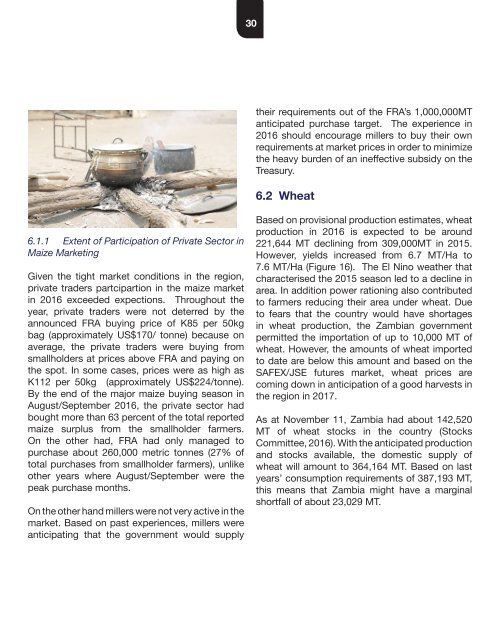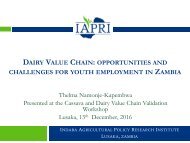ZAMBIA
IAPRI-Booklet
IAPRI-Booklet
You also want an ePaper? Increase the reach of your titles
YUMPU automatically turns print PDFs into web optimized ePapers that Google loves.
30<br />
their requirements out of the FRA’s 1,000,000MT<br />
anticipated purchase target. The experience in<br />
2016 should encourage millers to buy their own<br />
requirements at market prices in order to minimize<br />
the heavy burden of an ineffective subsidy on the<br />
Treasury.<br />
6.2 Wheat<br />
6.1.1 Extent of Participation of Private Sector in<br />
Maize Marketing<br />
Given the tight market conditions in the region,<br />
private traders partcipartion in the maize market<br />
in 2016 exceeded expections. Throughout the<br />
year, private traders were not deterred by the<br />
announced FRA buying price of K85 per 50kg<br />
bag (approximately US$170/ tonne) because on<br />
average, the private traders were buying from<br />
smallholders at prices above FRA and paying on<br />
the spot. In some cases, prices were as high as<br />
K112 per 50kg (approximately US$224/tonne).<br />
By the end of the major maize buying season in<br />
August/September 2016, the private sector had<br />
bought more than 63 percent of the total reported<br />
maize surplus from the smallholder farmers.<br />
On the other had, FRA had only managed to<br />
purchase about 260,000 metric tonnes (27% of<br />
total purchases from smallholder farmers), unlike<br />
other years where August/September were the<br />
peak purchase months.<br />
On the other hand millers were not very active in the<br />
market. Based on past experiences, millers were<br />
anticipating that the government would supply<br />
Based on provisional production estimates, wheat<br />
production in 2016 is expected to be around<br />
221,644 MT declining from 309,000MT in 2015.<br />
However, yields increased from 6.7 MT/Ha to<br />
7.6 MT/Ha (Figure 16). The El Nino weather that<br />
characterised the 2015 season led to a decline in<br />
area. In addition power rationing also contributed<br />
to farmers reducing their area under wheat. Due<br />
to fears that the country would have shortages<br />
in wheat production, the Zambian government<br />
permitted the importation of up to 10,000 MT of<br />
wheat. However, the amounts of wheat imported<br />
to date are below this amount and based on the<br />
SAFEX/JSE futures market, wheat prices are<br />
coming down in anticipation of a good harvests in<br />
the region in 2017.<br />
As at November 11, Zambia had about 142,520<br />
MT of wheat stocks in the country (Stocks<br />
Committee, 2016). With the anticipated production<br />
and stocks available, the domestic supply of<br />
wheat will amount to 364,164 MT. Based on last<br />
years’ consumption requirements of 387,193 MT,<br />
this means that Zambia might have a marginal<br />
shortfall of about 23,029 MT.



